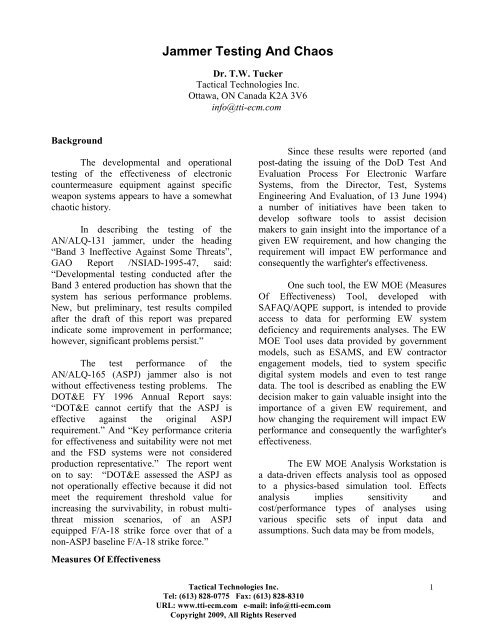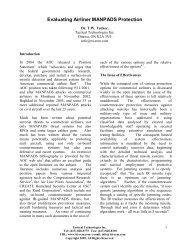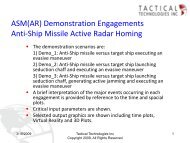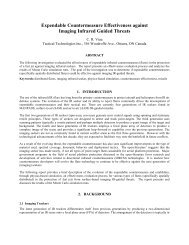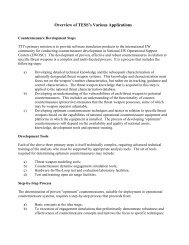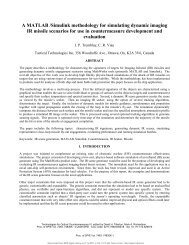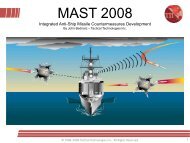Jammer Testing and Chaos Paper - Tactical Technologies Inc.
Jammer Testing and Chaos Paper - Tactical Technologies Inc.
Jammer Testing and Chaos Paper - Tactical Technologies Inc.
Create successful ePaper yourself
Turn your PDF publications into a flip-book with our unique Google optimized e-Paper software.
<strong>Jammer</strong> <strong>Testing</strong> And <strong>Chaos</strong><br />
Dr. T.W. Tucker<br />
<strong>Tactical</strong> <strong>Technologies</strong> <strong>Inc</strong>.<br />
Ottawa, ON Canada K2A 3V6<br />
info@tti-ecm.com<br />
Background<br />
The developmental <strong>and</strong> operational<br />
testing of the effectiveness of electronic<br />
countermeasure equipment against specific<br />
weapon systems appears to have a somewhat<br />
chaotic history.<br />
In describing the testing of the<br />
AN/ALQ-131 jammer, under the heading<br />
“B<strong>and</strong> 3 Ineffective Against Some Threats”,<br />
GAO Report /NSIAD-1995-47, said:<br />
“Developmental testing conducted after the<br />
B<strong>and</strong> 3 entered production has shown that the<br />
system has serious performance problems.<br />
New, but preliminary, test results compiled<br />
after the draft of this report was prepared<br />
indicate some improvement in performance;<br />
however, significant problems persist.”<br />
The test performance of the<br />
AN/ALQ-165 (ASPJ) jammer also is not<br />
without effectiveness testing problems. The<br />
DOT&E FY 1996 Annual Report says:<br />
“DOT&E cannot certify that the ASPJ is<br />
effective against the original ASPJ<br />
requirement.” And “Key performance criteria<br />
for effectiveness <strong>and</strong> suitability were not met<br />
<strong>and</strong> the FSD systems were not considered<br />
production representative.” The report went<br />
on to say: “DOT&E assessed the ASPJ as<br />
not operationally effective because it did not<br />
meet the requirement threshold value for<br />
increasing the survivability, in robust multithreat<br />
mission scenarios, of an ASPJ<br />
equipped F/A-18 strike force over that of a<br />
non-ASPJ baseline F/A-18 strike force.”<br />
Measures Of Effectiveness<br />
Since these results were reported (<strong>and</strong><br />
post-dating the issuing of the DoD Test And<br />
Evaluation Process For Electronic Warfare<br />
Systems, from the Director, Test, Systems<br />
Engineering And Evaluation, of 13 June 1994)<br />
a number of initiatives have been taken to<br />
develop software tools to assist decision<br />
makers to gain insight into the importance of a<br />
given EW requirement, <strong>and</strong> how changing the<br />
requirement will impact EW performance <strong>and</strong><br />
consequently the warfighter's effectiveness.<br />
One such tool, the EW MOE (Measures<br />
Of Effectiveness) Tool, developed with<br />
SAFAQ/AQPE support, is intended to provide<br />
access to data for performing EW system<br />
deficiency <strong>and</strong> requirements analyses. The EW<br />
MOE Tool uses data provided by government<br />
models, such as ESAMS, <strong>and</strong> EW contractor<br />
engagement models, tied to system specific<br />
digital system models <strong>and</strong> even to test range<br />
data. The tool is described as enabling the EW<br />
decision maker to gain valuable insight into the<br />
importance of a given EW requirement, <strong>and</strong><br />
how changing the requirement will impact EW<br />
performance <strong>and</strong> consequently the warfighter's<br />
effectiveness.<br />
The EW MOE Analysis Workstation is<br />
a data-driven effects analysis tool as opposed<br />
to a physics-based simulation tool. Effects<br />
analysis implies sensitivity <strong>and</strong><br />
cost/performance types of analyses using<br />
various specific sets of input data <strong>and</strong><br />
assumptions. Such data may be from models,<br />
<strong>Tactical</strong> <strong>Technologies</strong> <strong>Inc</strong>.<br />
Tel: (613) 828-0775 Fax: (613) 828-8310<br />
URL: www.tti-ecm.com e-mail: info@tti-ecm.com<br />
Copyright 2009, All Rights Reserved<br />
1
simulations, hardware-in-the-loop testing <strong>and</strong><br />
open air testing. Physics-based simulation<br />
implies computer models containing<br />
mathematical representations of a system<br />
whose behavior is based on physics. Such<br />
simulations may be the sources for input data<br />
used in effects analysis tools.<br />
Simulation, Test <strong>and</strong> Evaluation<br />
It may be observed that a number of<br />
issues <strong>and</strong> program initiatives, including<br />
Developmental <strong>and</strong> Operational T&E<br />
procedures, <strong>and</strong> Simulation Based<br />
Acquisition, each impinge on the primary<br />
concern of gaining consistently testable<br />
effectiveness results from jamming<br />
equipment in development, test <strong>and</strong><br />
operational use.<br />
In addressing this merging of M&S<br />
<strong>and</strong> T&E issues the Joint Advanced<br />
Distributed Simulation (JADS) EW Test<br />
Team was m<strong>and</strong>ated to determine if<br />
Advanced Distributed Simulation could help<br />
the EW community resolve several<br />
interrelated testing process issues.<br />
The first issue of concern to the JADS<br />
EW Test Team was that of the correlation of<br />
test results for ECM systems that are under<br />
test across the modeling <strong>and</strong> simulation,<br />
hardware-in-the-loop (HITL), <strong>and</strong> open-air<br />
test regimes. This concern would appear to<br />
be related to validating software simulations<br />
in relation to hardware performance as<br />
measured in HITL <strong>and</strong> open-air tests. An<br />
absence of results correlation may imply,<br />
among other factors, that the software model<br />
is not valid, that some elements of the HWIL<br />
simulation are not valid or that input data <strong>and</strong><br />
test results in all three test domains were not<br />
complete or not sufficiently accurate.<br />
The second issue of concern to the<br />
JADS EW Test Team was that of model <strong>and</strong><br />
simulation fidelity. Adequate fidelity implies<br />
that the software simulation is a reasonably<br />
good match to the hardware that it is<br />
simulating. The absence of an adequate match<br />
between hardware <strong>and</strong> software may give rise<br />
to uncorrelatable or widely varying test results,<br />
particularly if the software simulation does not<br />
model key portions of the hardware in<br />
sufficient detail. Such absence of correlatable<br />
output results may also result from a mismatch<br />
between the parameter values loaded in the<br />
simulation. There remains, however, the<br />
outst<strong>and</strong>ing issue of identifying the key<br />
parameters <strong>and</strong> subsystems of the hardware<br />
that affect over-all system performance <strong>and</strong><br />
ECM response.<br />
Of fundamental importance to the<br />
JADS EW Test design was the statistical<br />
correlation of EW measures of performance<br />
(MOP) across the test phases. JADS found<br />
generally poor correlation between the test<br />
results taken in the three domains despite their<br />
attempts to limit variance sources. They<br />
observed that the primary variance source for<br />
most measures was operator action. JADS<br />
found wide variances in the test results even<br />
when threat operator actions were constrained<br />
to a fixed set of allowable actions.<br />
JADS’ observed that their “inability to<br />
execute a test that sufficiently removed<br />
operator variance from the test casts a shadow<br />
on the EW community’s ability to make<br />
statistical analysis a feasible aid for decision<br />
makers faced with determining the worth of<br />
systems designed to work against human<br />
operators.” Measures such as jamming-tosignal<br />
ratio <strong>and</strong> tracking error that produce<br />
thous<strong>and</strong>s of samples were reported to make<br />
the problem worse. The statistics test used was<br />
<strong>Tactical</strong> <strong>Technologies</strong> <strong>Inc</strong>.<br />
Tel: (613) 828-0775 Fax: (613) 828-8310<br />
URL: www.tti-ecm.com e-mail: info@tti-ecm.com<br />
Copyright 2009, All Rights Reserved<br />
2
found to produce no useful comparisons for<br />
that many samples making the test useless for<br />
those two measures.<br />
Countermeasure Success Criteria<br />
The success or failure of deception<br />
countermeasures in dynamic engagements<br />
with threat tracking radars can be traced<br />
primarily to the relative influence of the<br />
jamming signal <strong>and</strong> the target return signal<br />
on the radar’s tracking when both signals are<br />
simultaneously present within one or more of<br />
the radar’s tracking discriminators. In simple<br />
terms the tracking discriminators (in angle,<br />
range <strong>and</strong>/or Doppler) are the components in<br />
the radar that continuously adjust the position<br />
of the radar’s tracking cell (normally under<br />
servo control) to keep it positioned over the<br />
selected target (which may be a deception<br />
signal). This target tracking data is, in turn,<br />
used by the threat radar to control or<br />
comm<strong>and</strong> the missile or gun system.<br />
A primary <strong>and</strong> fundamental property<br />
of discriminators is that they possess very<br />
non-linear input-to-output characteristics.<br />
Furthermore, when faced with two<br />
simultaneous signals a discriminator’s<br />
characteristic distorts even further.<br />
Tracking discriminators are, in most<br />
weapon designs, an integral part of servo<br />
controlled tracking loops that are themselves<br />
modeled by differential equations. Therefore<br />
a simulation that adequately models the<br />
interaction between deception<br />
countermeasure <strong>and</strong> threat tracking radar<br />
inherently must include a number of nonlinear<br />
differential equations to provide a<br />
reasonably accurate description of the radar.<br />
The simple observation that an<br />
adequate simulation of a threat radar should, to<br />
attain adequate fidelity, be modeled with nonlinear<br />
differential equations may have profound<br />
consequences on the correlation between<br />
software simulation results <strong>and</strong> hardware test<br />
results. One basic property of non-linear<br />
differential equations is that they exhibit what<br />
has come to be referred to often as “chaotic<br />
behavior”. One of the properties of non-linear<br />
differential equations, particularly for<br />
interactions that occur over a period of time is<br />
that the outcome can be very strongly<br />
dependent on very small changes in initial<br />
input parameters or conditions.<br />
Chaotic Behavior A Fundamental Issue<br />
Simply put chaotic systems are<br />
potentially unstable, exhibiting a very sensitive<br />
dependence on initial conditions. This chaotic<br />
behavior of non-linear, time-evolving, dynamic<br />
systems was first formally reported by a<br />
meteorologist, Edward Lorenz in 1963. While<br />
running computer simulations on a set of three<br />
nonlinear equations, Lorenz found that, by<br />
rounding off initial parameters from four<br />
decimal places to two, the time paths of the<br />
equations diverged exponentially over time.<br />
This finding has given rise to a new<br />
mathematical discipline, often referred to as<br />
<strong>Chaos</strong> Theory, that has been studied<br />
intensively by mathematicians for about 35<br />
years. Chaotic behavior has been found in a<br />
large variety of complex systems from weather<br />
systems to human behavior in organizations.<br />
Inherently, because of their systems’<br />
non-linearities, chaotic behavior is a property<br />
of the dynamic interaction between<br />
countermeasures <strong>and</strong> tracking radars, with or<br />
without a human operator in the loop.<br />
<strong>Tactical</strong> <strong>Technologies</strong> <strong>Inc</strong>.<br />
Tel: (613) 828-0775 Fax: (613) 828-8310<br />
URL: www.tti-ecm.com e-mail: info@tti-ecm.com<br />
Copyright 2009, All Rights Reserved<br />
3
Impact of <strong>Chaos</strong> On ECM Simulation,<br />
Test <strong>and</strong> Evaluation<br />
When the results of the AN/ALQ-131<br />
<strong>and</strong> AN/ALQ-165 tests <strong>and</strong> the results found<br />
by the JADS EW Test Team are viewed from<br />
the perspective of the expected chaotic<br />
behavior of the non-linear systems under test,<br />
the findings of large variances, noncorrelatable<br />
results <strong>and</strong> effectiveness criteria<br />
that are not met, are entirely predictable.<br />
There are a number of implications of this<br />
observation.<br />
If the software simulations do not<br />
adequately model various key non-linearities<br />
in the radar system, such as those possessed<br />
by the tracking discriminators, saturating<br />
amplifiers <strong>and</strong> antenna gimbal limiters, their<br />
ability to adequately match the performance<br />
of the hardware being simulated is suspect at<br />
best. It would appear that incorporation of<br />
such non-linear models in simulations is a<br />
necessary, but not sufficient condition, for<br />
adequate fidelity. Even if such nonlinearities<br />
are included in the simulations the<br />
potential for chaotic behavior implies that, in<br />
the execution of related software <strong>and</strong><br />
hardware tests, increased focus must be<br />
placed on the accurate measurement of the<br />
input parameters <strong>and</strong> initial conditions.<br />
There must also be a correlation of input<br />
conditions before any expectations may be<br />
developed regarding correlation of output<br />
results from hardware <strong>and</strong> software tests.<br />
When developmental <strong>and</strong> operational<br />
test <strong>and</strong> evaluation is carried out involving<br />
the dynamic interaction of countermeasure<br />
<strong>and</strong> radar systems <strong>and</strong> that testing intends to<br />
demonstrate that the equipment meets<br />
specific performance criteria as defined<br />
during requirements development, then those<br />
criteria should reflect the potential existence<br />
of chaotic behavior. Within the context of the<br />
Simulation Based Acquisition process, in<br />
which simulation is to be applied across the<br />
spectrum of acquisition from requirements to<br />
testing, the application of simulations that<br />
include appropriate non-linearities at each<br />
stage should assist in ameliorating the test<br />
problems.<br />
Control Of <strong>Chaos</strong><br />
It seems reasonable to ask that, if<br />
chaotic <strong>and</strong> unpredictable behavior is inherent<br />
in the countermeasure-radar interaction, does<br />
this imply that there are likely be limits to the<br />
percentage of times that specific<br />
countermeasure may be effective against<br />
specific radar <strong>and</strong> weapon systems? In the<br />
absence of a body of research <strong>and</strong> engineering<br />
focused on this question it seems premature to<br />
endeavor to provide a definitive answer.<br />
However, here are several thoughts. If<br />
countermeasures can be structured to avoid the<br />
radar’s operation in non-linear regions of its<br />
operating regime then perhaps results can be<br />
linearly extrapolated <strong>and</strong> outcomes reasonably<br />
predictable.<br />
Finally, in the research community, particularly<br />
in the non-linear systems discipline, there are<br />
now serious efforts to control chaotic behavior<br />
of complex non-linear systems through various<br />
schemes of adaptive control. Could such<br />
adaptive control be incorporated in the mode<br />
selection process in jammers to optimize their<br />
effectiveness?<br />
<strong>Tactical</strong> <strong>Technologies</strong> <strong>Inc</strong>.<br />
Tel: (613) 828-0775 Fax: (613) 828-8310<br />
URL: www.tti-ecm.com e-mail: info@tti-ecm.com<br />
Copyright 2009, All Rights Reserved<br />
4


